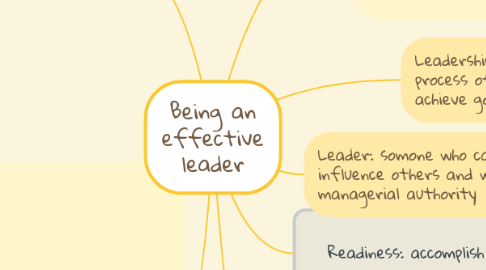
1. Contemporary views of leadership
1.1. Chrismatic leader
1.1.1. Managing Power
1.1.1.1. Legitimate
1.1.1.2. Coercive
1.1.1.3. Reward
1.1.1.4. Referent
1.1.1.5. Expert
1.1.2. Developing Trust
1.1.3. Empowering Employees
1.1.4. Leading Across Cultures
1.1.5. Visionary leadership
1.1.6. Transformatinal Leaders
2. Early leadership theories
2.1. Trait theories ( 1920s-1930s)
2.2. Behavioral theories
2.2.1. Autoratic style
2.2.2. Democratic style
2.2.3. Laissez-faire style
2.3. The Ohio State Studies (2 dimensions of leader behavior)
2.3.1. Initiating structure
2.3.2. Consideration
2.4. Michigan Studies
2.4.1. Employee oriented
2.4.2. Production oriented
3. Readiness: accomplish a specific task
4. Fieldler contingency model
4.1. Task structure ( rated as either high or low )
4.2. Leader-member relations ( rated as either good or poor )
4.3. Position power ( rated as either strong or weak )
5. Leader: somone who can influence others and who has managerial authority
6. Leadership: skill of leaders, the process of influencing a group to achieve goals
7. Hersey and Blanchard's SLT
7.1. Situation Leadership Theory
7.1.1. Participating (low task - high relationship)
7.1.1.1. Able but unwilling to do what the leader wants
7.1.2. Delegating (low task-low relationship)
7.1.2.1. unable but willing to do the necessary job tasks
7.1.3. Telling (high task - low relationship)
7.1.3.1. unable and unwilling to take responsibility for doing somethings
7.1.4. Selling (high task-high relationship)
7.1.4.1. both able and willing to do what is asked of them

